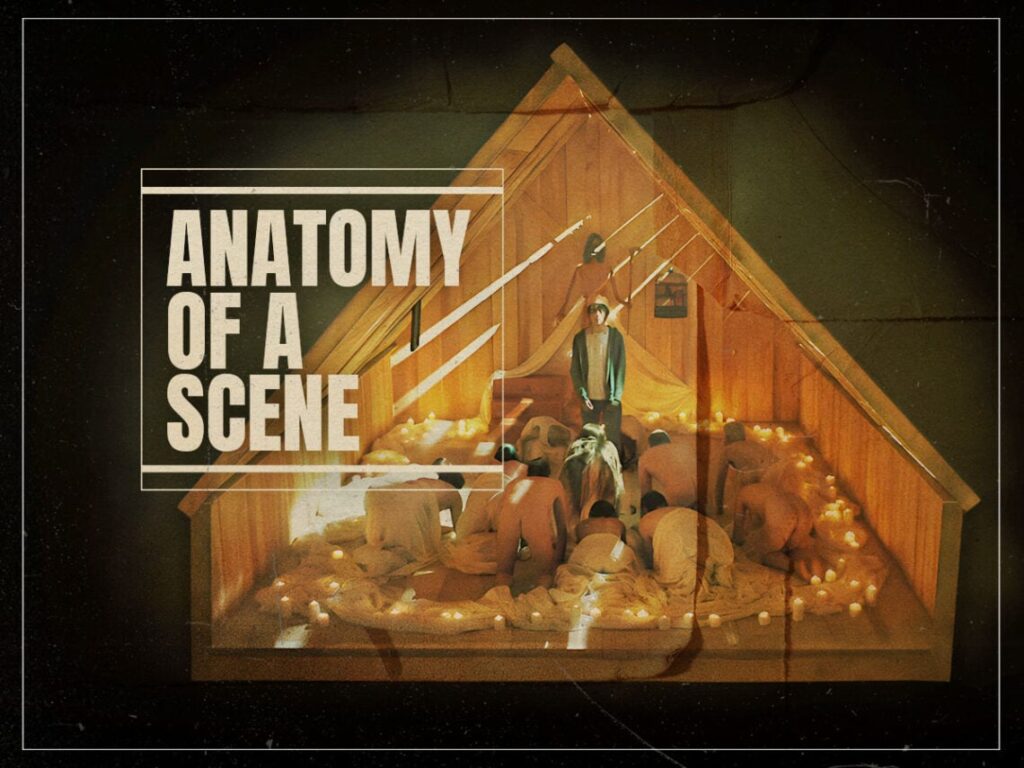Anatomy of a Scene: Dissecting the treehouse coronation in ‘Hereditary’
 Posted On
Posted On
(Credits: Far Out / A24)
Ari Aster’s feature debut, Hereditary, not only captivated horror audiences and heralded a new wave of trauma-centered “elevated” horror, but it also left countless viewers deeply unsettled. Emotionally raw and unforgiving, this is not a movie that pulls its punches. And bookending the film are two of the most memorable and stomach-churning scenes in recent movie history, all for very different reasons.
Around 30 minutes into Hereditary, a pivotal scene plunges the film into an unrelenting spiral of grief-fueled horror. This shocking moment is the tragic death of Charlie, played by Millie Shapiro. Struggling with anaphylactic shock, she leans out of a speeding car’s window for air, only for her head to collide with a roadside post in a grisly and very sudden end.
Just describing that scene is brutal enough, but Aster doesn’t shy away from cruelty. A shot of Charlie’s ant-infested and decaying severed head on the side of the road kicks in like a jump scare, married with the psychically damaging wail of Toni Collette playing a mother who just found out the unthinkable has occurred. That’s a moment that sticks with the audience, and no matter what tricks Aster plays the rest of the runtime, he’s now doing it to a viewing public in an altered state, shell-shocked and ready to follow him down whatever twists and turns he has laid out for us.
But the scene we are here to conduct a postmortem on today is not Charlie’s death but her rebirth—that’s the bookend at the other end of the film, as Charlie’s older brother is finally overcome by demon-worshipping cultists and something else takes over his body. We follow as he ascends into the family treehouse to be crowned as a demon king named Paimon.
It’s a mesmerising sequence, delivering a constant combo of visual punches – the naked and smiling cultists lurking in the dark beneath the treehouse, the small crowd of kneeling devotees above. Then there’s the jolt of a pair of headless corpses, also in mid-genuflection. A shock as we realise they belong to the boy’s mother and grandmother. And then there’s what they appear to be praying to – a twisted effigy headed by the severed head of his younger sister, wearing some kind of twisted crown.
Each new sight is shown in close-up before returning to the face of Peter (or Charlie, or Paimon). At this point, Peter, the teenage boy played by Alex Wolff, has likely already left his body to be replaced by Paimon—one of the eight kings of Hell. But unlike Peter, the audience is still right there with his body, watching as the movie takes a sharp turn from a ghost house fright fest into something more terrible and sublime.
Paimon is a demon mentioned in the real-world text The Lesser Key of Solomon, along with other ancient grimoires. He is described as a hoarse-voiced crowned avatar riding a camel who carries knowledge of all secret things. Ahead of his camel is said to sound a procession of loud trumpets.
And it appears Aster did his homework and took the Ars Goetia as a bit of light bedtime reading – the score in this scene is bursting with the drone of trumpets sounding a funeral dirge to herald the king’s return to the mortal plane. Colin Stetson’s score is all-consuming, with soaring moments of wine glass-breaking pitch speckled throughout the body-vibrating drone of the lower end.
Then it all stops. Peter – or Peter’s body – stands there in complete silence as an off-screen voice comforts him, calling him by his sister’s name. For that’s the final cruel joke of the movie, that Peter’s erratic driving leading to the death of his possessed sister was the same thing that put him in the crosshairs of the demon king.
The comforting voice of the cultist reminds me of another A24 satanic horror with a similar ending – Robert Egger’s The Witch. The largely unseen Black Philip is presented with an almost chocolatey tone of voice, and the same effect is used here with the cultist. You can feel that these people are there to nurture and support their new demon overlord – it’s almost nice. What it really is is supremely unsettling.
[embedded content]
Related Topics


